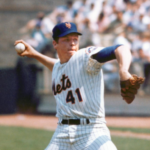Tom Hanks’ Jimmy Dugan character says, “There’s no crying in baseball”. But many today will also say, “There’s no crying broke in baseball.”
Fans, sports bloggers, and sports enthusiasts nationwide spend big money on season tickets, concessions, memorabilia, periodicals, books, and all kinds of financial trade-offs to show their appreciation for their team. WIth all the money flowing through the organizations, I could see why it’s difficult to believe that the team you love and adore has no money to spend. Certain small market teams such as the Pirates, the Royals, and even the Marlins, at a few points over the years, may have had legitimate reasons for crying broke. That argument is even arguable with teams like the Reds, the Mariners, the Twins, or even the Nationals. But this is harder to swallow for a team that resides in the mecca which is New York City, Flushing to be exact.
Spending is a topic bandied about by many over the years and especially after the Madoff debacle that put a huge spotlight on the spending and investment acumen of the Wilpon contingent. It was promised publicly and in print that the scandal would not affect spending this season. Such names from John Lackey to Joel Pineiro to Jason Marquis to Bengie Molina have approached the front door but never actually came in to sit down and have a cup of coffee. Dalliances with these free agents have left a foul taste in the mouths of New York fans across the country. Why? Because there is a perception (Is perception still reality these days?) that the Mets have avoided spending where they could. It’s not my money (at least, not in the literal sense) that is not being spent but we, the fans, make a huge investment and so, we should expect rightfully a quality product on the field. I can’t advocate giving Matt Holliday an 8 year deal for over $120 million and call that fiscally responsible. However, giving Bengie Molina and Jason Marquis 2 year deals would have been responsible despite what you feel about them talent-wise. There appears to be a problem in Flushing.
Big market teams are not afraid to spend and the fact of the matter is, they get their return in most instances with deep runs in the playoffs. It doesn’t always mean a World Series visit or win but they have admirable seasons practically every year, just like large market teams should. The Yankees and the Red Sox (and to a degree, the Phillies, especially after their World Series win) have been notorious for spending whatever is necessary to produce a winning ball club. They have huge names, but somehow, somewhere, it results in production on the field. 1B Mark Teixiera and P’s A.J. Burnett & C.C. Sabathia have changed the face of the team, while putting a huge dent in the Yankees’ wallet. (The Yankees lavished $423.5 million on C. C. Sabathia, A. J. Burnett and Mark Teixeira not including additional spending in the draft and the farm = $441 million in offseason contracts). Agreed with the moves or not, you can’t argue with the result. I was one of those guys dogging the Yanks for buying championships, but truthfully, and without bias, if you got the money and you can get players, and not break any rules, why not? Isn’t it the least you could do for your fans? The Red Sox have acted similarly and to a lesser degree, they have found success in the AL East and in the league. The New York Mets are in a large market. The New York Mets spend money. If you agree with both statements, the only disconnect is this: what they are spending their money on?
I found a NY Times article that raises more questions about the Mets and their ability to spend.
“The Mets divvied $3,134,300 among their 35 signed picks, more than 50 percent less than their 2008 outlay, when they had two first-round selections and a first-round supplemental pick. By contrast, the average for all 30 teams was a shade more than $6 million. Without a pick until the second round, No. 72 over all, the Mets’ spending was destined to decrease. But their 2009 strategy resembled that of a small-market club that sometimes bypasses talented players in earlier rounds because it does not want to spend more on them than players available deeper in the draft.”
Jim Callis from Baseball America had this to say:
“With a brand-new ballpark and a television network, the Mets’ revenues are probably among the top five clubs in baseball,” said Jim Callis, the executive editor of Baseball America and an expert on player development. ”After spending about $6.5 million when they had extra picks last year, do I think they could have found the money this year? Yeah, I think they could have. It just comes down to the willingness to spend.”
Seriously, look at Donald Sterling of the NBA’s Los Angeles Clippers franchise. He was blasted year after year in the press, not simply because his team was battered on a regular basis on the hardwood. It was because he was made of money and he refused, for some reason, to spend it wisely on his team to build a contender. He took the discount route and his team spent years in obscurity. Things have improved almost in direct contrast with the fact that he has begun to spend more money on free agents. It’s not coincidental or happenstance. It’s fact.
Spend money and you make the fans and other owners and teams know that you mean business when it comes to improving your team. How many times within the last two years have you seen teams get into bidding wars for players knowing that the Yankees were all in on them? I bet it will take you a while to find some because it didn’t happen often. Other teams knew they couldn’t outspend our outbid the Yankees. They lost the battle before it even began. That’s purchasing power at its finest. They know that they have an advantage and leverage over all the other teams and they use it whenever possible to better their team. Young players coming out of the farm system wants to play for them. Free agents want to be on their team. That’s what it’s all about. Developing your farm system goes without saying. No need to mention it, but spending the right way turns a contender into a pretender. Check the numbers and you will see the difference between the Red Sox’s 86 year drought and their historic World Series victory. They added an ace in Curt Schilling and a closer in Keith Foulke and it made the difference.
The Mets have become an afterthought in the city where they have made history many times. Any one of us would trade the back pages for a World Series title. It’s as simple as dollars and cents in the right places and the Amazins can return to respectability and the big-market swagger they never should have departed from. Last year, the Yankees spent $201.4 million. The Mets spend $149.3 million. The Mets don’t have to spend more than the Yankees, but they definitely have to spend better than them.













